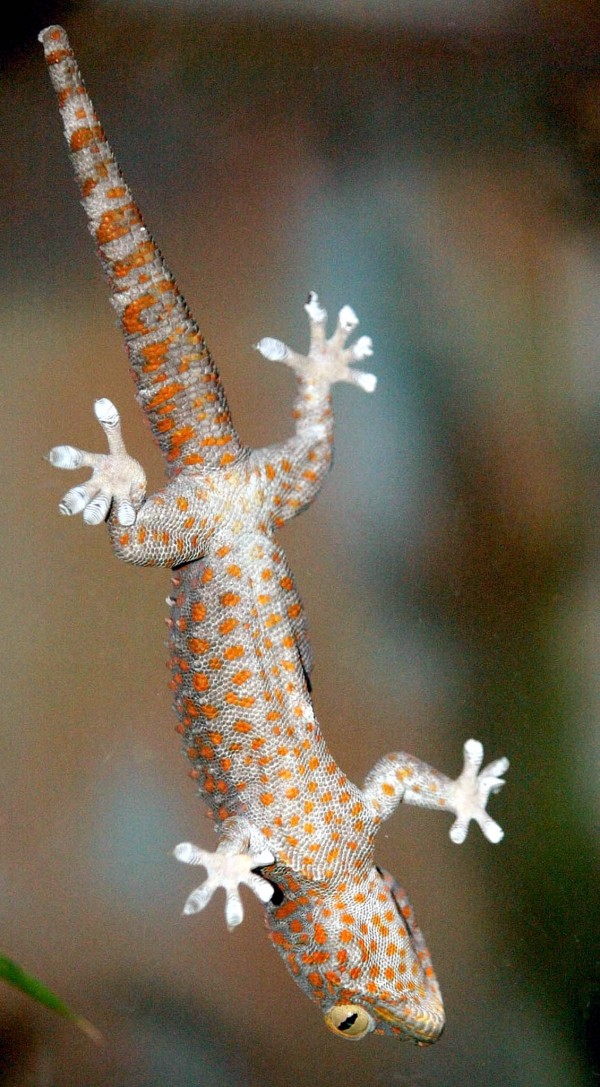Gecko Toe Hairs + Electrons = Super Stickiness
| Marc Maligalig | | Aug 13, 2014 02:04 AM EDT |
(Photo : Reuters)
New research into the toe hairs of gecko aims to recreate in synthetic substances the incredible adhesive properties unique to these tropical lizards.
The stickiness of a gecko's toes is the reason a gecko can climb walls and attach itself to surfaces with ease. The creatures can even run across any surface at 20 body lengths per second by quickly changing the state of stickiness of its toe hairs.
Like Us on Facebook
Alex Greaney, an engineering professor at the Oregon State University in Corvallis, and his colleagues have discovered geckos don't really stick to surfaces.
Instead, these lizards do something to make themselves sticky.
"It's this incredible synergy of the flexibility, angle and extensibility of the hairs that makes it possible," said Greaney.
Scientists reported that geckos have hundreds of microscopic hairs or bristles on their toes called "setae."
These setae are the sole reason for the gecko's ability to attach to surfaces and remain agile.
The bristles branch out further into hundreds of even smaller hairs called "spatula."
Geckos exploit a property in chemistry called the van der Waals force to cling to and run on vertical surfaces. The van der Waals force makes electrons from the molecules on the surface of the wall interact with electrons of the molecules in the gecko's hair.
This interaction forces the setae to stick to a wall.
There are a number of interesting technologies that take advantage of this fact. Two such technologies include the development of handheld paddles that let individuals climb walls and a treatment for closing cuts and lacerations without the need of stitches.
For the last 10 years, scientists have been studying hairs on the gecko's feet to create artificial adhesives with minute fibers that mimic the gecko's unique ability to stick to surfaces.
TagsScience, scientific research, Bioinspiration and Biomimetics, Biology, Gecko, Animals
©2015 Chinatopix All rights reserved. Do not reproduce without permission
EDITOR'S PICKS
-

Did the Trump administration just announce plans for a trade war with ‘hostile’ China and Russia?
-

US Senate passes Taiwan travel bill slammed by China
-

As Yan Sihong’s family grieves, here are other Chinese students who went missing abroad. Some have never been found
-

Beijing blasts Western critics who ‘smear China’ with the term sharp power
-

China Envoy Seeks to Defuse Tensions With U.S. as a Trade War Brews
-

Singapore's Deputy PM Provides Bitcoin Vote of Confidence Amid China's Blanket Bans
-

China warns investors over risks in overseas virtual currency trading
-

Chinese government most trustworthy: survey
-

Kashima Antlers On Course For Back-To-Back Titles
MOST POPULAR
LATEST NEWS
Zhou Yongkang: China's Former Security Chief Sentenced to Life in Prison

China's former Chief of the Ministry of Public Security, Zhou Yongkang, has been given a life sentence after he was found guilty of abusing his office, bribery and deliberately ... Full Article
TRENDING STORY

China Pork Prices Expected to Stabilize As The Supplies Recover

Elephone P9000 Smartphone is now on Sale on Amazon India

There's a Big Chance Cliffhangers Won't Still Be Resolved When Grey's Anatomy Season 13 Returns

Supreme Court Ruled on Samsung vs Apple Dispute for Patent Infringement

Microsoft Surface Pro 5 Rumors and Release Date: What is the Latest?










